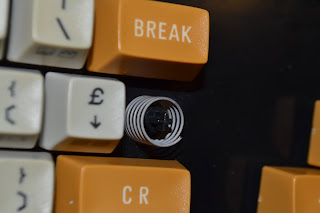Having completed Martin's first Luxman R-1040 (and his L-80V, both documented on these pages), he wanted his second R-1040 re-capped and set up.
...why not ?
I wasn't going to do a post about this, as the job was going to be identical to the previous, but it turned out differently...
Well, after the arduous task of re-capping was complete, it was time for a test & to set the bias etc ...
This is the part where I wished I'd powered it up before I'd re-capped it ...
The bias is drifting around all over the place on the Right hand channel power amplifier. I set it up, and all appears OK, look at the meters a few minutes later and it's drifted. It's also very slightly crackling.
"That's bound to be the pot"
The bias pot, VR202b, is replaced, to no avail ... meh. VR201a (DC offset) also proves to be innocent.
Checking the DC conditions around the amplifier, things are moving around a lot around Q204b, a 2SC945. Not having a replacement, I swap out the same transistor from the other amp. No change.
I'm starting to think I may have swapped a cap out, and may have fitted a brand new, but faulty cap. Prime suspect being C205b and maybe C204b ... they both check out OK.
I then decide to probe round the stage, under quiescent conditions with the oscilliscope. The voltage on the base of Q204b (and the collector of Q204b) is not steady. I scope the supply back. "Spiky" on both sides of R212b, but steady the other side of R211b ... R211b somehow noisy?? I've seen this happen with old carbon resistors in valve amps before. R211b (3.9K) is duly evicted and replaced. The supply is now steady and the amp quiet...
The bias is now set for 45mA per side, and remains rock sold. DC offset is also set, and doesn't budge.
There's no audio on the left hand channel. Not from any source.
I put a tone into the left hand channel and trace the signal through the amp. It meanders it's way through the source switching, through the balance and volume control, then disappears across the volume control buffer PCB...
The signal enters on P301a, via the volume pot VR301a, which, thankfully is innocent, as it's one of those 4 pin affairs (used for balance) and the signal appears at the base of Q301a. The DC conditions are, once again, off here. The -23V is fine at R309, but woefully low after R306a. The voltage on the output capacitor should be -16V, it's -2.3V. Thinking back to the amplifier, R306 is checked, and proves it's innocence. It's not going to be C302a, as that is fed by a 33K resistor, and isn't capable of pulling the rail down that far. Q301a ? Q302a?... I'm betting on Q302a, a 2SC1345 (it was easier to remove!) ... a quick diode test in circuit gives inconclusive results, so it's pulled out of circuit, and put on the Peak tester...
... eh ? Should be NPN...
... nah, it's sick as a dog ...
... and has given up having much in the way of gain!
Evil thing...
Looking the in transistor drawer, I don't have a replacement, so a BC547 is used, making sure the legs are bent to ensure the base and collector go to the right holes!
DC conditions are restored, as is sound!
I think there was originally some foam tape against the chassis to provide some insulation between the volume control PCB and the front of the chassis. This has long since turned to dust and vanished, so a bit of capton tape is used when the PCB is refitted.
After the dial illumination is converted to LED, the amp is reassembled and soak tested with the most excellent Pop Gossip by The International Teachers of Pop
































